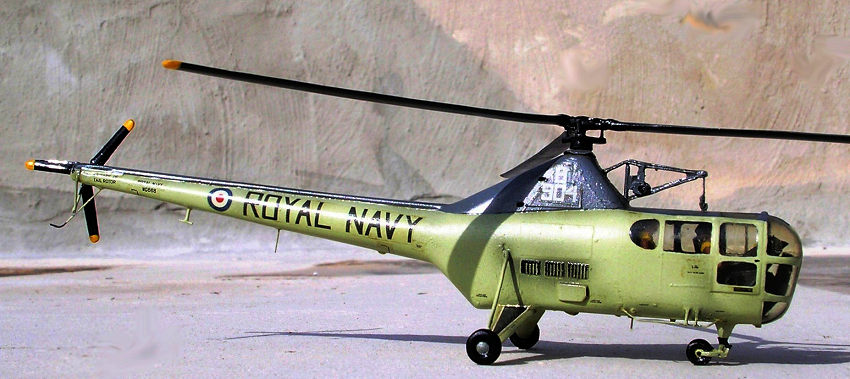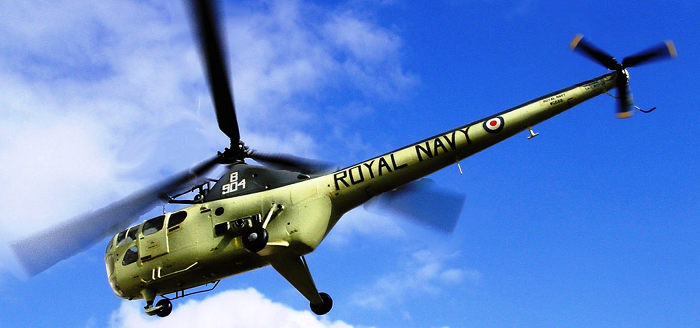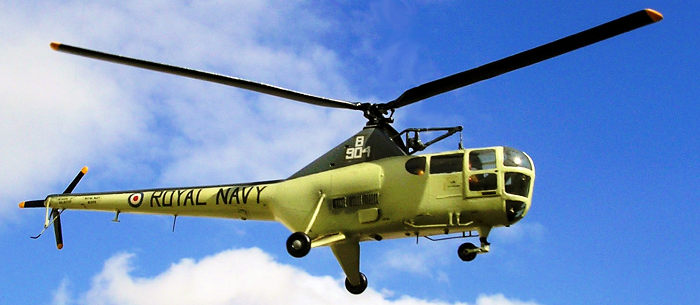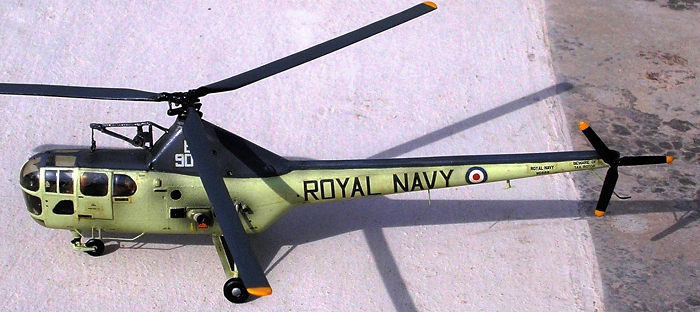
Britavia 1/72 Dragonfly HR.3
| KIT #: | |
| PRICE: | $ |
| DECALS: | Two options |
| REVIEWER: | Carmel J Attard |
| NOTES: | Vacuform with metal parts. |

| HISTORY |
 Shore
based Dragonflies such as the type that was for a number of yeas attached to FAA
base at Hal-Far (HMS Falcon) in Malta replaced Supermarine Sea Otter amphibious
biplanes in the Air-Sea rescue role. They also took part in many civilian rescue
operations from RNAS Lossiemouth, RNAS Culdrose and RNAS Lee-on-Solent. The
Dragonfly was a most reliable helicopter and was gradually phased out of service
in the late 1950s making way for the more powerful and capacious Westland
Whirlwind.
Shore
based Dragonflies such as the type that was for a number of yeas attached to FAA
base at Hal-Far (HMS Falcon) in Malta replaced Supermarine Sea Otter amphibious
biplanes in the Air-Sea rescue role. They also took part in many civilian rescue
operations from RNAS Lossiemouth, RNAS Culdrose and RNAS Lee-on-Solent. The
Dragonfly was a most reliable helicopter and was gradually phased out of service
in the late 1950s making way for the more powerful and capacious Westland
Whirlwind.
The Royal Air Force operated the HC2 and HC4 variants and it served in some numbers with various commonwealth forces.
| THE KIT |
 Released
way back in 1984 by Britavia Models, one among the cottage industry category,
the vac form kit was very welcomed being the first issue of the type back then.
The kit has a moulding standards as good as any yet seen in vac form. Detail
parts such as wheels, undercarriage legs and tail rotor parts are in white
metal. The decal sheet is of top quality with a choice of markings for two Royal
Navy Helicopters in the two standard Navy colour schemes. The kit comes with
8-page instructions. This includes accurate three view scale plans, close-up
photos and information in great detail; assembly instructions and decal
placement side view.
Released
way back in 1984 by Britavia Models, one among the cottage industry category,
the vac form kit was very welcomed being the first issue of the type back then.
The kit has a moulding standards as good as any yet seen in vac form. Detail
parts such as wheels, undercarriage legs and tail rotor parts are in white
metal. The decal sheet is of top quality with a choice of markings for two Royal
Navy Helicopters in the two standard Navy colour schemes. The kit comes with
8-page instructions. This includes accurate three view scale plans, close-up
photos and information in great detail; assembly instructions and decal
placement side view.
| CONSTRUCTION |
The kit comes in transparent
styrene which is to a good advantage in view of the amount of cabin glazing. The
vac mouldings consist of the two fuselage halves, cabin bulkheads, floor,
 undercarriage
support struts and the three rotor blades. The quality of styrene is not the
type that can be glued with liquid cement and only super glue in fact was used
all along.
undercarriage
support struts and the three rotor blades. The quality of styrene is not the
type that can be glued with liquid cement and only super glue in fact was used
all along.
The parts were carefully cut out and the excess styrene sanded away, rubbing down using wet and dry paper. The cabin floor and bulkheads were then cemented in place to one of the fuselage halves ensuring that when the two sides are closed the bulkhead leaves no excess that can prevent the complete fit of the halves.
One also need to take care not to smear the clear glazing with excess glue. The interior is painted dark grey. The white metal instrument panel and seats, now painted black are added to the cockpit interior. A crew figure decorated in custom RN custom overall was added to the front seat. Strips of plastic card fixed at intermittent spaces were cemented inside the edges to assist in keeping the fuselage halves well aligned.
 The parts
were then glued and held tightly together with tape until dry. Undercarriage
parts were then glued to the fuselage in pre drilled holes making sure that the
fuselage has the desired ‘sit’ when it rests on the undercarriage legs. Glazed
areas were then masked with Tamiya tape.
The parts
were then glued and held tightly together with tape until dry. Undercarriage
parts were then glued to the fuselage in pre drilled holes making sure that the
fuselage has the desired ‘sit’ when it rests on the undercarriage legs. Glazed
areas were then masked with Tamiya tape.
It was the turn for the carefully cut blades to fix to the prop hub. Filler at fuselage seam was sanded smooth. Aerials, rotor pylon mounted winch and hook were all added.
My choice fell on the one having dark sea grey top and sky undersides using Humbrol paints. After painting the rotor blades, an overall coat of Future was applied and decals added to the kit. These were opaque, well registered and overall were of top quality and included minute stencil markings. Finally the model was given a coat of satin finish and the glaze maskings removed.
| CONCLUSIONS |
I enjoyed building the Dragonfly kit. It is the licence built development of the American S-51 first flown in 1946. Unit cost of each machine was £12,000, a far cry from what rescue helicopters cost these days.
 This model
made a significant addition to my post-war RN aircraft section which blended
well with a Sea Fury, Sea Vampire, Attacker, Seahawk, Firefly and Avenger
aircraft models of the same era. It also brought back early memories of the type
flying all over the island in those early good old days.
This model
made a significant addition to my post-war RN aircraft section which blended
well with a Sea Fury, Sea Vampire, Attacker, Seahawk, Firefly and Avenger
aircraft models of the same era. It also brought back early memories of the type
flying all over the island in those early good old days.
Attached is a picture of a Dragonfly passing through the roads of Kalafrana being ferried to Hal Far land base from where it was to start service with the Royal Navy.
4 September 2017
Copyright ModelingMadness.com
If you would like your product reviewed fairly and fairly quickly, please contact the editor or see other details in the Note to Contributors.
Back to the Main Page Back to the Review Index Page Back to the Previews Index Page